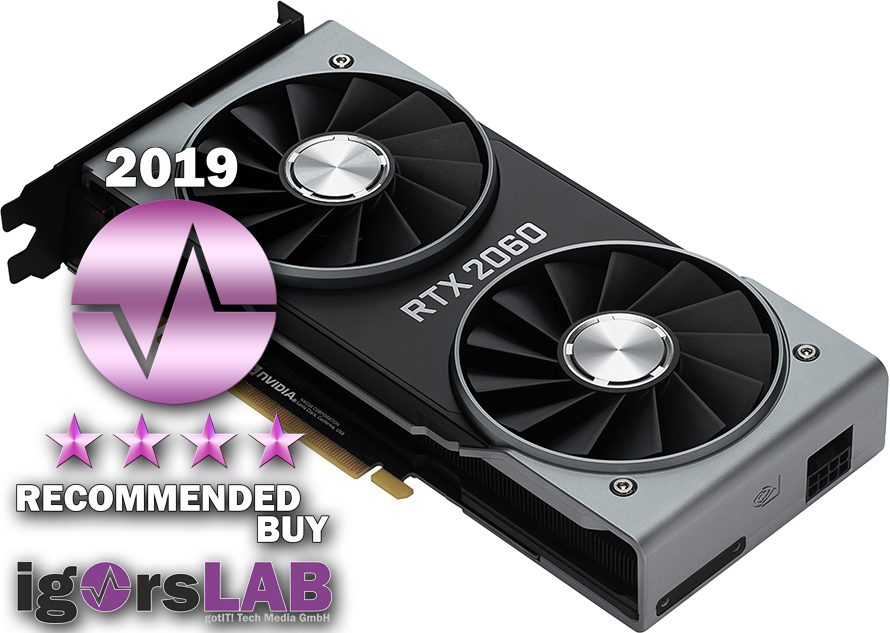Summary
At the rather lonely peak, where the GeForce RTX 2080 Ti, the RTX 2080 and even the RTX 2070 are quite lonely, Nvidia is the only provider far and wide. The resulting single-player prices clearly reflect the lack of competition. If you want to play in this upper league as a player, then you have no choice but to accept the "luxury tax" of the company. The new GeForce RTX 2060, on the other hand, lands in a more competitive area, where there are also competitors with strong products. And that has (pleasant) consequences.
AMD's Radeon RX Vega 56 may even be able to compete with a lower price, while the Radeon RX Vega 64 should show a similar performance. Many older GeForce GTX 1070 and 1070 Ti in sales are also still vying for the attention of potential buyers. In short, it simply wouldn't have been enough for the new GeForce RTX 2060 to replace a similarly fast Pascal-based card at the same price, to add RT and tensor cores as a manufacturer and to communicate to everyone that the appropriate games will soon be will come.
No, the GeForce RTX 2060 simply had to be significantly faster and not really more expensive than the competition in terms of price, in order to finally meet with broad acceptance. Today's launch still raises a number of questions. Why is Nvidia using the RTX 2070's more expensive PG160 board with 10 layers for launch, when it would have done the PG161 with 6 layers, but which should not be available until February? What, or rather who, puts so much pressure on Nvidia here that it dispenses with wider margins just to keep the price of 369 euros of RRP?
I'm not an oracle, but if you look at the benchmarks like that, an RX Vega56 or Vega64 in 7nm, which would also be significantly cheaper to produce, would be a very serious opponent. Perhaps this also explains the haste with which this "pre-launch" was pulled through with selected media just before the CES and the price? Real cards are not expected until 15.01.2019 anyway and the still inexpensive board partner cards with the PG161 board should not be released in stores before the beginning of February.
Because of all the circumstances, I would like to thank all those who supported me in this article. In cooperation with my US colleagues Chris Angelini, we have at least got an extensive launch article in German, even if I still lack some details for my taste. Of course, I will deliver this later on to the usual extent.

Conclusion
The GeForce RTX 2060 is really fast and highly competitive for its targeted price range. It is also the card whose RTX mark-up is the most tolerable. Thus, once the road prices of the cheaper board partner cards have settled down at some point, it would also have a real chance to take on the role of the old GeForce GTX 1070, which at the time was par excellence in the P/L ratio and in the acceptance of the cleaners in Nvidia's Pascal cards, and perhaps even surpassed this.
The only downside is the cropped memory, because even if you can get there in Full HD with the 6GB, on WQHD and higher it can soon become quite tight, from a perspective point of view. But how else can we counter the cannibalization of the larger (and more expensive) GeForce RTX 2070? But in the end, for many users, the only thing that counts is the here and now.
It has to be said fairly that this card, considering the achievable performance, deserves an explicit purchase recommendation. If it is possible in the width to offer together with the partners also good and interesting for the end customer in the range around 330 Euro street price and below, it would probably be difficult even an RX Vega56 in 7nm to set clear accents. In addition, the announced bundle with either Anthem or Battlefield 5 is certainly an additional purchase incentive.
In addition, Nvidia will open from the 15th. The VESA standard Adaptive Sync, which is also supported by the FreeSync used by AMD, is also used on January 1. This currently applies to GeForce owners who call a monitor with variable refresh rate their own, even if only 12 monitors have been certified at the moment. But if you want, you can then manually flip the switch and hope that the monitor will support it. However, there is no guarantee of comprehensive compatibility. So it's a bit like hell freezing. At least a little bit.
With the GeForce RTX, Nvidia has sent a mass-produced RTX road fighter into the race, which leaves nothing to be desired except for the memory expansion when it comes to Full HD and, for me, WQHD. However, it is also very clear from the price what would be possible if there were equivalent competitor products in the upper performance segments. But we certainly have to be patient. Let's wait and see.
- 1 - Vorstellung, Daten und Testsystem
- 2 - Was kann Turing besser?
- 3 - Mesh- und variables Shading
- 4 - DLSS und Raytracing
- 5 - Tear Down: Platine und Kühler
- 6 - Battlefield V (DXR)
- 7 - AotS: Escalation (DX12)
- 8 - Destiny 2 (DX11)
- 9 - Far Cry 5 (DX11)
- 10 - Forza Motorsport 7 (DX12)
- 11 - GTA V (DX11)
- 12 - Metro Last Light (DX11)
- 13 - Shadow of the Tomb Raider (DX12)
- 14 - Ghost Recon Wildlands (DX11)
- 15 - The Division (DX12)
- 16 - The Witcher 3 (DX11)
- 17 - Wolfenstein 2 (Vulkan)
- 18 - Leistungsaufnahme, Temperaturen und Geräuschentwicklung
- 19 - Zusammenfassung und Fazit































Kommentieren